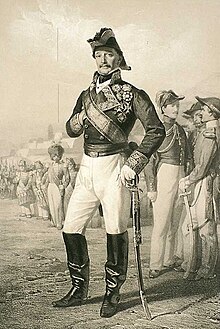Fernando Fernández de Córdova
Don Fernando Fernández de Córdova y Valcárcel, 2nd Marquess of Mendigorría (2 September 1809, in Buenos Aires[1] – 30 October 1883, in Madrid[2]), was a Spanish military, politician, and Prime minister of Spain for one day.
Fernando Fernández de Córdova | |
|---|---|
 | |
| Prime Minister of Spain | |
| In office 17 July 1854 – 18 July 1854 | |
| Monarch | Isabella II |
| Preceded by | Luis José Sartorius |
| Succeeded by | Angel de Saavedra |
| In office 13 June 1872 – 16 June 1872 | |
| Monarch | Amadeo I |
| Preceded by | Francisco Serrano |
| Succeeded by | Manuel Ruiz Zorrilla |
| Personal details | |
| Born | Fernando Fernández de Córdova y Valcárcel 2 September 1809 Buenos Aires, Viceroyalty of the Río de la Plata, Spain |
| Died | 30 October 1883 (aged 74) Madrid, Spain |
Biography
editBorn into a military family as the son of José de Córdoba y Rojas, he and his brother Luis fought in the First Carlist War on the side of Isabelinos. He belonged to the Partido Moderado.[3]
In 1848, he became Lieutenant General and as Captain General of Catalonia during the Second Carlist War,[4] he put down the isolated rebel cells in that region by early 1849.
In May 1849 he was sent to Italy to help to protect Pope Pius IX against the Italian Revolution of 1848.[5] He led a force of 4,000 Spanish soldiers, who were deployed in Gaeta and placed at the Pope's disposition.[6] This marked the Spanish Army's first expeditionary venture into Italy since the War of the Austrian Succession a hundred years prior. Spanish columns secured the region and assisted the French in their operations at Itri.
He became War Minister and was even Prime Minister for one day (18 July 1854) in full political crisis,[7][8] which ended when Baldomero Espartero became head of the "progressive Biennium" of 1854–1856.
Fernando had always supported Queen Isabella II of Spain, but backed the Revolution of 1868 against the Crown, and joined the Radical Democratic Party.
In 1872, under King Amadeo I of Spain, he became acting Prime Minister between 13 June and 16 June,[9] before retiring completely from political life in 1873.
References
edit- ^ Rada, José María Azcona y Díaz de (1946). Zumalacárregui: estudio crítico de las fuentes históricas de su tiempo (in Spanish). Instituto de estudios políticos. p. 173. Retrieved 8 February 2024.
- ^ Diccionario enciclopédico hispano-americano de literatura, ciencias y artes: Apéndice 24-25. Segundo apéndice 26-28 (in Spanish). Montaner y Simón. 1891. p. 229. Retrieved 8 February 2024.
- ^ Headrick, Daniel R. (1981). Ejercito y politica en España: 1866-1898 (in Spanish). Editorial Tecnos. p. 57. ISBN 978-84-309-0867-7. Retrieved 8 February 2024.
- ^ Pavia, Manuel (1851). Memorias sobre la guerra de Cataluña, desde Margo de 1847 hasta Setiembre del mismo año y desde Noviembre de 1847 á Setiembre de 1848 (in Spanish). Imprenta de Dr. B. Gonzalez. p. 282. Retrieved 8 February 2024.
- ^ Ferrandis, Manuel; Beirão, Caetano (1966). Historia contemporánea de España y Portugal (in Spanish). Editorial Labor. p. 219. Retrieved 8 February 2024.
- ^ Bécker, Jerónimo (1924). Historia de las relaciones exteriores de España durante el siglo XIX (apuntes para una historia diplomática) (in Spanish). Estab. tip. de J. Ratés. p. 155. Retrieved 8 February 2024.
- ^ Los ministros en España desde 1800 á 1869: historia contemporánea por uno que siendo español no cobra del presupuesto (in Spanish). Administración, Calle de Oriente. 1869. p. 906. Retrieved 8 February 2024.
- ^ Herrero, Teodora Gómez (1902). Diccionario-guía legislativo español (in Spanish). Estab. Tip. de R. Fé. p. 749. Retrieved 8 February 2024.
- ^ Colección legislativa de España: continuación de la colección de decretos (in Spanish). Imprenta del Ministerio de gracia y justicia. 1872. pp. 679–681. Retrieved 8 February 2024.